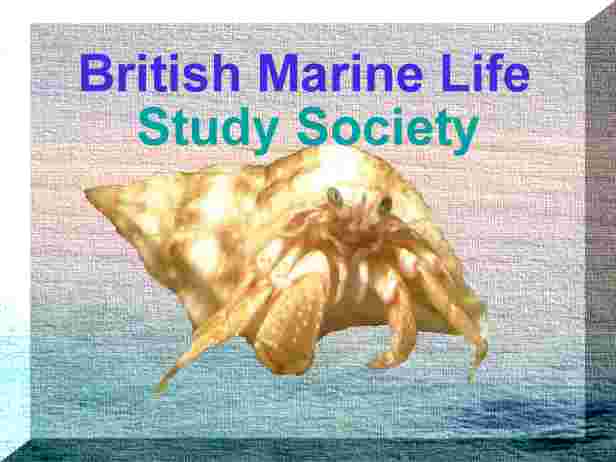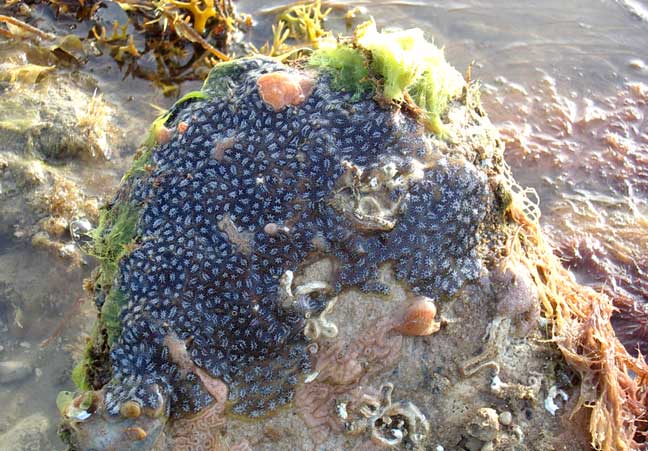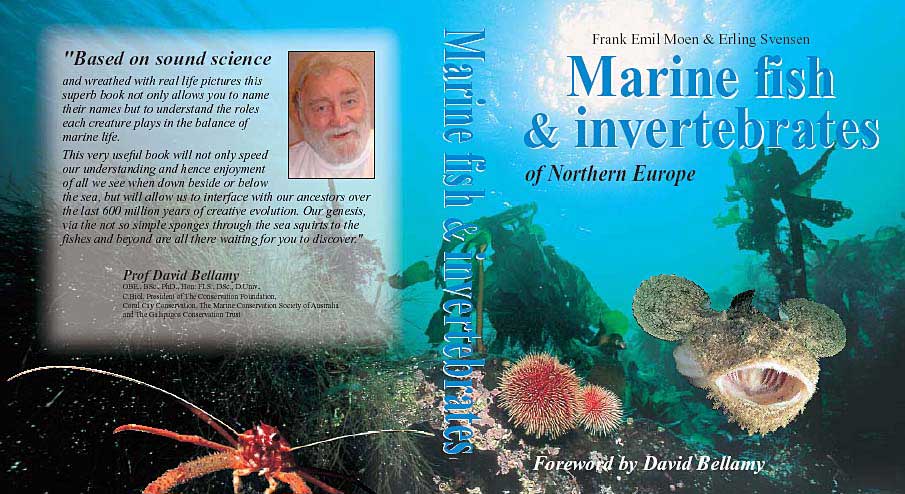 |
 |

|
The bulletin is designed for Microsoft Explorer 4 and above using medium fonts at a resolution of 800 x 600. Subscribe and unsubscribe options are at the foot of this page. |
|
|
| MARINE
LIFE NEWS
Reports
of marine wildlife from all around the British Isles, with pollution incidents
and conservation initiatives as they affect the flora and fauna of the
NE Atlantic Ocean.
28-29
August 2004
The main watch site was at Brighton 28 August 2004, on the west arm of the Brighton Marina (East Sussex). This was the site for members of the public to join in the watch and find out more about the project. 12 people took part in the watch for periods between 1 and 2 hours. Many members of the public stopped to find out more about our project and we also received many calls on the hotline number. At 14.42 pm we spotted a Bottle-nosed Dolphin, Tursiops truncatus, a bit further out to sea than usual, possibly due to the increase in pleasure vessels coming to and from the marina being a bank holiday. It was thought by one of the watchers (and myself) that there could have been a second dolphin but could not be sure as the sea conditions had changed from a sea state 1 to a sea state 3 during the day. Two Bottle-nosed Dolphin sightings were also recorded at Eastbourne during the event, one on Saturday 28th and the other on Sunday 29th August. A further sighting was made at Hastings also on the Sunday. A sighting at East Preston, (West Sussex) of two Bottle-nosed Dolphins seen on 21st August and another sighting at Brighton on Thursday 26th were also reported to us during the event. These were reported on our new sighting hotline number 07773610036 following press coverage for the event. As most of these sightings reported two Bottle-nosed Dolphins, it is tempting to think they may all be of the same dolphins, but of course its impossible to know. Due to the great increase in public involvement and the number of Sussex sightings reported, this is easily our most successful Sussex Watch in the last three years of participating in the National Whale and Dolphin Watch. A big thanks to everyone who took part, telephoned our hotline or kept an eye out for dolphins over the weekend A major contribution to the success of this year's Sussex watches has been due to funding through the Wildlife Trusts South East Marine Programme, which is supported by English Nature through DEFRAs Aggregate Sustainability Fund. This meant we were able to set up and support a larger number of Sussex watch sites this year. These included Worthing, Shoreham, and Littlehampton where watches were manned by trained volunteers. The results of the National Watch can be found on the Sea Watch Foundation website at www.seawatchfoundation.org.uk Stephen
Savage
August
2004
Report
from Doug
Herdson (National
Marine Aquarium, Plymouth)
on the Marine Wildlife of the North-east Atlantic Ocean Group
Image
of the this species discovered off Norway (to see how bizarre it is)
This
"spoon" worm is classified in the Phylum Echiura.
Bonellia viridis Information Page (by René Hessling) The distribution of Bonellia viridis around the British Isles is unclear. I have not received any reports from divers in British waters before. although off Norway it will be found in depths of 25 metres or more. It occurs frequently in shallow water in the Mediterranean Sea, e.g. off Chios, a Greek island in the Aegean Sea. More
Information
More Echiurans (By Erling Svensen) c.
20 August 2004
Report
by Paul Parsons (Sompting)
The Sunfish, Mola mola, photograph was taken on 7th August 2004 about half a mile off Old Harry Rocks in Dorset. I spotted the Sunfish on the surface and I have seen them in the same area before. Normally when approached they swim towards the bottom at high speed. This time the Sunfish swam towards the boat and even allowed me to touch it, it made no attempt to swim away. It swam around the boat a few times and came back to the swim platform again. I could see it had sea lice on its back and I guess it was trying to get them removed. The fish appeared to be in good health, a fantastic site to see. Report
and Photograph by Lee Ford
BMLSS
Sunfish
Sunfish Reports 2004 6 August
2004
Report
by Trevor Opie on the Cornish
Wildlife (Yahoo Group)
NB: Gilthead
bream is a southern species which is now believed to breed off the south-west
coast of Britain.
1 August
2004
Report
by Nick
Greatorex-Davies
BMLSS
Triggerfish Page
Early
August 2004
Report
by Mrs Linda Short
Report
by Lin Roberts
31 July 2004 The two Triggerfish, Balistes capriscus, we saw underneath the Palace Pier, Brighton, were of different sizes the larger being darker in colour and about 30 cm from tooth to tail. They both looked healthy and lively. Report
by Paul Parsons (Sompting)
All
reports by Andy Horton unless the credits are given
Links for News Reports: Helford (Cornwall) Marine Conservation Area |
| PICTURE
GALLERY
Each month, at least one special marine image will be published from images sent to the BMLSS. This can be of the seashore, undersea world or any aspect of the marine natural world, especially the underwater life, but not restricted to life beneath the waves. Topical inclusions may be included instead of the most meritorious, and images will be limited to the NE Atlantic Ocean and adjoining seas, marine and seashore species and land and seascapes. -----------------------------------------------------------------------------------------------------------------------------
Shore Topography Series The name of the particular coast should be included and the grid reference, if known. Print photographs can be included in Exhibitions and on the BMLSS Web Sites and electronic publications. Electronic images in *.JPG format can also be considered for the web site. They should not exceed 150K in size. Photographers submitting pictures should indicate if they wish them to be considered fro inclusion as confirming permission takes work and time and can delay publication of the news bulletins. Click
on the album for more links (On-line link)
|
| DIARY
In
chronological order, the most recent events are at the top of the page.
Events open to the public, free or for a nominal charge only are included.
Most Seminars need to be booked in advance.
BIOSIS Conference Calendar for Zoology (Major Link of all biological conferences around the world) -----------------------------------------
Plymouth Talks Series 2004 Facilities are available for schools, linked to the national curriculum. Talks
start at 7:00 p.m.
Please
reserve your place by calling the Aquarium on 01752 275204
------------------------------------------------------------------------------------------------------------------------
Unless otherwise stated, seminars are held on Fridays at 4:15 pm------------------------------------------------------------------------------------------------------------------------- -------------------------------------------------------------------------------------------------------------------------
|
| PUBLIC
AQUARIA NEWS
|
| Public Aquaria List |
| NEW
PUBLICATIONS & WEB PAGES
FILMS 18
June 2004
---------------------------------------------------------------------------------------------------------------------------
Marine
fish & invertebrates
In May 2004 the English edition of the very popular Norwegian Marine Fauna (Dyreliv I havet) was published. Prof. David Bellamy has written the foreword. More than one thousand underwater photographs and 608 pages with updated information on marine fish and invertebrates from nearly all marine phylum in Northern European waters. The largest newspaper in Norway, Aftenposten gave the Norwegian edition 6 out of 6 points in a book review. It is in use at all major higher marine biology studies in Norway. The
English edition is translated by Prof Fredrik Pleijel and Dr. Sabine Cochrane.
"Marine fish & invertebrates of Northern Europe” is written for anyone with a general interest in marine animal life, and who would like to learn more about their way of life and behaviour, about the role they play in the drama of nature, and the benefit and nuisance they are to man. The main portion of the book is arranged in such a way that the different animal species are presented in a natural, systematic order. More than one thousand magnificent colour photos of animals taken in their natural environment support the informative text highlighting the characteristics of each animal. “Marine fish & invertebrates” covers the North European marine fauna and is a readable experience in itself. In addition, the book is an important aid and source of inspiration to all who delight in the ocean with its hidden life whether if be hobby, study or profession. The book is available from Aquapress in the UK, Skandisk, Inc. USA and KOM in Norway . .
WEB SITES NAUSICAÄ
- French National Sea Experience Center
NAUSICAÄ - French National Sea Experience Center, in Boulogne-sur-Mer (Northern France), is a Science Center entirely dedicated to the relationship between Mankind and the Sea. Its goal is to incite the general public to discover the sea and to love it, while raising its awareness on the need for a better management of marine resources. Within the scope of this mission, NAUSICAÄ gives access, on its recently redesigned web site, to a database containing links to the most interesting web sites concerning the sea-related topics and marine activities. -------------------------------------------------------------------------------------------------------------------- MOLLUSC WORLD |
SOCIETY
INFORMATION
The British Marine Life Study Society are responsible for producing the journal GLAUCUS, which is the first publication exploring the marine life of the seas surrounding the British Isles available to the general public.
the TORPEDO Electronic News Bulletin. The Glaucus 2002 CD-ROM was sent out to Premier BMLSS members in January 2003.
Messages to the first address will not receive any guarantee of a reply and from year 2003, the old EMail address is expected to fall into disuse. ---------------------------------------------------------------------------------------------------------------------------- Membership 2004
|
|
If
you receive this Bulletin direct from the British Marine Life Study Society
it will contain only hypertext and image (*.htm *.gif & *.jpg) files.
|
|
These
pages are not designed for the default settings on the Page Set-ups of
your browser. I recommend viewing in Microscope Internet Explorer 6 and
altering the right and left hand columns in the Page Set-up menu to 9 mm
(from 19 mm).
Some of the images may not display if you have changed your directory for downloaded files. The images may also not display properly if your settings on your EMail software do not allow you do this automatically. When received in Pegasus the format is changed slightly, but the bulletin is still readable. Torpedo compiled by Andy Horton Background design by Nicolas Jouault , Andy Horton and other contributors 8 September 2004 |
Compiled on Netscape Composer 4.7 and other programs












